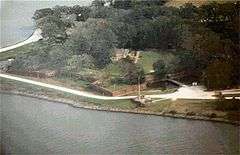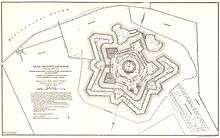Fort Jackson, Louisiana
|
Fort Jackson | |
 | |
  | |
| Location | Plaquemines Parish, Louisiana, USA |
|---|---|
| Nearest city | Triumph, Louisiana |
| Built | 1822–32 |
| NRHP Reference # | 66000379 |
| Significant dates | |
| Added to NRHP | October 15, 1966[1] |
| Designated NHL | December 19, 1960 |
Coordinates: 29°21′28″N 89°27′18″W / 29.35778°N 89.45500°W Fort Jackson is an historic masonry fort located some 40 miles (64 km) up river from the mouth of the Mississippi River in Plaquemines Parish, Louisiana. It was constructed as a coastal defense of New Orleans, between 1822 and 1832, and it was a battle site during the American Civil War.[2] It is a National Historic Landmark. It was damaged by Hurricanes Katrina and Rita, and its condition is threatened.


Fort Jackson is situated approximately 70 miles (110 km) south of New Orleans on the western bank of the Mississippi, approximately 2.5 miles (4.0 km) south of Triumph, Louisiana. The older Fort St. Philip is located opposite of Fort Jackson on the eastern bank; this West Bank fort was constructed after the War of 1812 on the advice of Andrew Jackson, for whom it is named.
The fort was occupied off and on for various military purposes from its completion until after World War I, when it served as a training station. It is now a National Historic Landmark and historical museum owned and operated by Plaquemines Parish.
Fort Jackson was the site of the Battle of Forts Jackson and St. Philip from April 16 to April 28, 1862, during the American Civil War. The Confederate-controlled fort was besieged for 12 days by the fleet of U.S. Navy Flag Officer David Farragut. Fort Jackson fell on April 28 after the Union fleet bombarded it and then sailed past its guns. A mutiny against the officers and conditions then occurred and the fort fell to the Union. Union forces then went on to capture New Orleans.[4]
Following the engagement, Fort Jackson was used as a Union prison. It was here that the French champagne magnate Charles Heidsieck was held for seven months on charges of spying.
Modern times
The fort was declared a National Historic Landmark in 1960.[5] It has been owned by Plaquemines Parish since 1962. In the 1960s, Leander Perez threatened to turn Fort St. Philip into a prison for advocates of desegregation ("outside agitators") who entered the Parish.[6] The fort site was later opened as a park.
The fort was badly damaged by Hurricane Katrina's storm surge in 2005. Between Katrina and Hurricane Rita the following month, much of the fort sat under water for up to six weeks. Many of the historic exhibits in the fort were destroyed, and the fort itself suffered structural damage.
The fort was used to treat oily birds in the early weeks of the Deepwater Horizon oil spill. The treatment facility was moved on July 4, 2010, to Hammond, Louisiana, in order to make it less vulnerable to hurricanes.[7]
See also
- National Register of Historic Places listings in Plaquemines Parish, Louisiana
- List of National Historic Landmarks in Louisiana
- Jackson Barracks, New Orleans
References
- ↑ National Park Service (2007-01-23). "National Register Information System". National Register of Historic Places. National Park Service.
- ↑ StoppingPoints.com. "Text of Fort Jackson historical marker".
- ↑ ORN I, v. 18, p.373.
- ↑ North & South, Volume 11, Number 2, Page 18, accessed April 16, 2010, "Mutiny at Fort Jackson"
- ↑ Patricia Heintzelman (May 21, 1975). "National Register of Historic Places Inventory-Nomination: Fort Jackson" (PDF). National Park Service. and Accompanying photos, aerial and exterior and interior, from 1935, 1959, and 1974. (852 KB)
- ↑ http://www.knowla.org/entry/1058/
- ↑ http://www.deepwaterhorizonresponse.com/go/doc/2931/737703/
External links
| Wikimedia Commons has media related to Fort Jackson, Louisiana. |